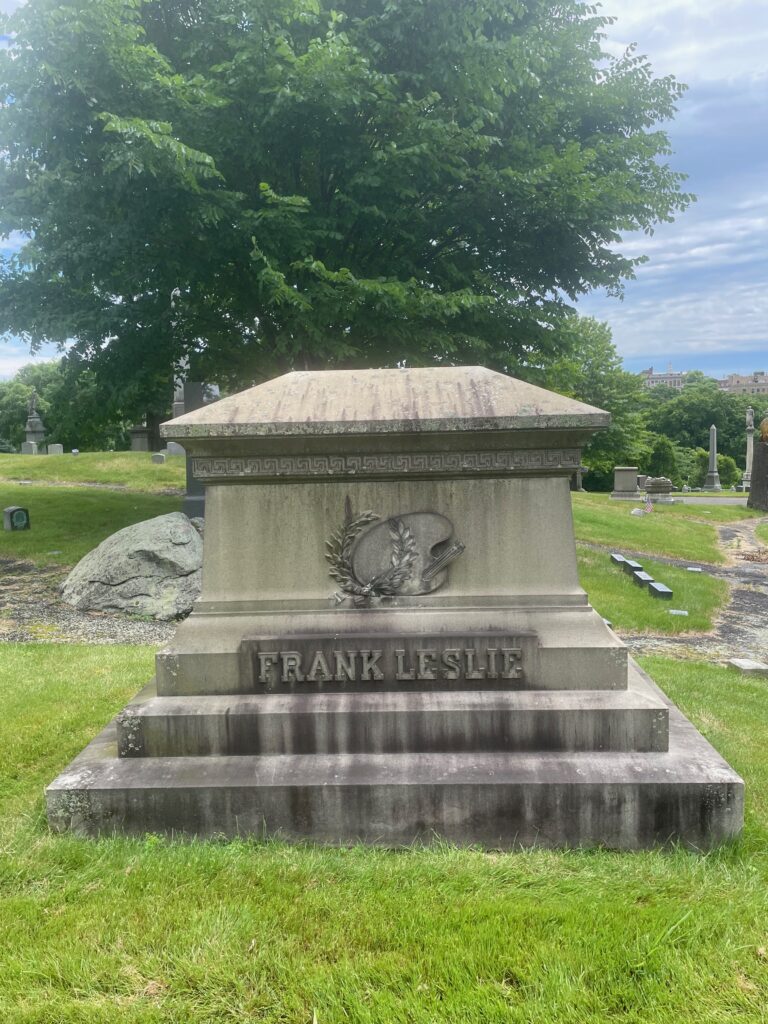Erik Visits an American Grave, Part 1,669
This is the grave of Frank Leslie.

Born in 1821 in Ipswich, England, Henry Carter grew up wealthy, the son of the owner of a prosperous glove company. His father intended for him to grow up and enter the business world and educated him to do so. But the young man was also interested in artistic matters and after observing silversmiths at work, he bought some silversmithing tools and trained himself to do it. He got far more into art than he did gloves. In 1838, he was working for his uncle in a dry goods firm as training to take over for his father eventually. But he hated it. He preferred drawing. He family was disgusted by the lazy kid. How dare he draw instead of sell gloves! But he was good at drawing and he started submitting his work to the Illustrated London News. Since he couldn’t give his own name because his family hated the art so much, he submitted it under the name of Frank Leslie and that became his adopted name as he rose in the pictoral world. He legally changed his name in 1857.
In 1848, Leslie came to the United States with his wife and three sons, though he and his wife divorced in 1860. He became a really good engraver and woodcutter. While working for Gleason’s Pictorial in Boston, he discovered new engraving methods that would speed the whole process up a lot. Like what once took a month could now take a day. That certainly got attention. P.T. Barnum hired Leslie in 1853 to work on his Illustrated News, but this was one business that the famous showman did not make work and it closed shortly after. So he started his own papers. The first was Frank Leslie’s Ladies’ Gazette of Fashion and Fancy Needlework, in 1854, but that didn’t last long.
The next year though, Leslie opened Frank Leslie’s Illustrated Newspaper. This became one of the most important newspapers in American history. It ran until 1922. Because of Leslie’s engraving skills, the paper rose to prominence in the Civil War. Americans were desperate for news of battles, both for ideological reasons and because their fathers, sons, and husbands were out there fighting them. As the death rates rose to numbers considered unfathomable before the war, the public wanted whatever information it could get. Leslie, by sending correspondents into the field, could produce engravings that gave a pictorial representation of the military, battles, and many other parts of the war. Actually, one of his freelancers–James O’Neill–was the only correspondent killed during the Civil War, when Quantrill’s Raiders, who did not take prisoners, killed him at the Battle of Baxter Springs.
Leslie’s engravings were not exactly subtle either. He went all-in on the blood and gore to the best he could in that style. He also pioneered the entire idea of a paper dominated by illustrations. There wasn’t another paper like his until well into the 1870s. So he had a near-monopoly of this kind of reporting and imagery. Thomas Nast probably is the most important illustrator of this period, but that’s because his simple, but iconic images so speak to us today about the rise and fall of emancipation and Reconstruction. But at the time, it was Leslie’s images that captured the hearts and minds of the average American who studied his work to understand more about the war.
Leslie had a pretty crazy second marriage. He married the wife of one of his editors, of his journal Frank Leslie’s Lady’s Magazine. That guy got sick, his wife Miriam took over the editorship for awhile, then Leslie fell in love with her, she divorced him, and they got married in 1874. They spent lavishly and took big trips and lived the high life at the same time that Leslie’s business was declining. They built a huge home in Saratoga Springs and hosted lavish parties for their rich friends. In 1877, they did a cross-country trip, which Miriam wrote up as From Gotham to the Golden Gate, which was one of those common travel narratives of the where rich people spend a lot of money traveling by train, living it up, and doing all sorts of adventurous side trips to the weird places of the American West still largely unknown to Americans. I’ve read a lot of books like this, though not this one. Meanwhile, the Panic of 1873 had impacted the business pretty significantly as people cut back on both their subscriptions and their advertising.
In 1880, Leslie suddenly died. Heart attack maybe, not sure. The business was a total mess, about $300,000 in debt. But Miriam took it over and kept it going. Amazingly, the following year she had her legal name changed to Frank Leslie! In fact, she’s a pretty fascinating person in her own right and is also buried here. She was born in New Orleans in 1836 and married four times. Leslie was the third. Her fourth husband was Oscar Wilde’s brother! When she died in 1914, she left her fortune to the suffragist Carrie Chapman Catt, even though her family contested the will. But she had become a strong suffragist and wanted the fortune to go to that cause.
Frank Leslie (both of them!) is buried in Woodlawn Cemetery, The Bronx, New York.
If you would like this series to visit more legends of the newspaper business, you can donate to cover the required expenses here. Brick Pomeroy, known primarily for hating Abraham Lincoln, is in McKean County, Pennsylvania and Sumner Archibald Cunningham, a truly terrible person who ran publications promoting Confederate nostalgia, is in Shelbyville, Tennessee. Previous posts in this series are archived here and here.


